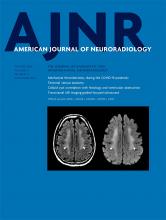Index by author
Benson, J.C.
- SpineYou have accessExophytic Lumbar Vertebral Body Mass in an Adult with Back PainJ.C. Benson, M.A. Vizcaino, D.K. Kim, C. Carr, P. Rose, L. Eckel and F. DiehnAmerican Journal of Neuroradiology October 2020, 41 (10) 1786-1790; DOI: https://doi.org/10.3174/ajnr.A6749
Bera, G.
- EDITOR'S CHOICEHead & NeckYou have accessAre Gadolinium-Enhanced MR Sequences Needed in Simultaneous 18F-FDG-PET/MRI for Tumor Delineation in Head and Neck Cancer?N. Pyatigorskaya, R. De Laroche, G. Bera, A. Giron, C. Bertolus, G. Herve, E. Chambenois, S. Bergeret, D. Dormont, M. Amor-Sahli and A. KasAmerican Journal of Neuroradiology October 2020, 41 (10) 1888-1896; DOI: https://doi.org/10.3174/ajnr.A6764
Consecutive patients who underwent simultaneous head and neck 18F-FDG-PET/MR imaging staging or restaging followed by surgery were retrospectively included in this study. Local tumor invasion and lymph node extension were assessed by 2 rater groups in 45 head and neck anatomic regions using 18F-FDG-PET/MR imaging. Two reading sessions were performed, one without contrast-enhanced sequences (using only T1WI, T2WI, and PET images) and a second with additional T1-weighted postcontrast sequences. The k concordance coefficient between the reading sessions and sensitivity and specificity for each region were calculated. There was excellent agreement between the contrast-free and postgadolinium reading sessions in delineating precise tumor extension in the 45 anatomic regions studied. The diagnostic accuracy did not differ between contrast-free and postgadolinium reading sessions, being 0.97 for both groups and both reading sessions. The authors conclude that gadolinium-based contrast administration showed no added value for accurate characterization of head and neck primary tumor extension and could possibly be avoided in the PET/MR imaging head and neck workflow.
Bergeret, S.
- EDITOR'S CHOICEHead & NeckYou have accessAre Gadolinium-Enhanced MR Sequences Needed in Simultaneous 18F-FDG-PET/MRI for Tumor Delineation in Head and Neck Cancer?N. Pyatigorskaya, R. De Laroche, G. Bera, A. Giron, C. Bertolus, G. Herve, E. Chambenois, S. Bergeret, D. Dormont, M. Amor-Sahli and A. KasAmerican Journal of Neuroradiology October 2020, 41 (10) 1888-1896; DOI: https://doi.org/10.3174/ajnr.A6764
Consecutive patients who underwent simultaneous head and neck 18F-FDG-PET/MR imaging staging or restaging followed by surgery were retrospectively included in this study. Local tumor invasion and lymph node extension were assessed by 2 rater groups in 45 head and neck anatomic regions using 18F-FDG-PET/MR imaging. Two reading sessions were performed, one without contrast-enhanced sequences (using only T1WI, T2WI, and PET images) and a second with additional T1-weighted postcontrast sequences. The k concordance coefficient between the reading sessions and sensitivity and specificity for each region were calculated. There was excellent agreement between the contrast-free and postgadolinium reading sessions in delineating precise tumor extension in the 45 anatomic regions studied. The diagnostic accuracy did not differ between contrast-free and postgadolinium reading sessions, being 0.97 for both groups and both reading sessions. The authors conclude that gadolinium-based contrast administration showed no added value for accurate characterization of head and neck primary tumor extension and could possibly be avoided in the PET/MR imaging head and neck workflow.
Bertolus, C.
- EDITOR'S CHOICEHead & NeckYou have accessAre Gadolinium-Enhanced MR Sequences Needed in Simultaneous 18F-FDG-PET/MRI for Tumor Delineation in Head and Neck Cancer?N. Pyatigorskaya, R. De Laroche, G. Bera, A. Giron, C. Bertolus, G. Herve, E. Chambenois, S. Bergeret, D. Dormont, M. Amor-Sahli and A. KasAmerican Journal of Neuroradiology October 2020, 41 (10) 1888-1896; DOI: https://doi.org/10.3174/ajnr.A6764
Consecutive patients who underwent simultaneous head and neck 18F-FDG-PET/MR imaging staging or restaging followed by surgery were retrospectively included in this study. Local tumor invasion and lymph node extension were assessed by 2 rater groups in 45 head and neck anatomic regions using 18F-FDG-PET/MR imaging. Two reading sessions were performed, one without contrast-enhanced sequences (using only T1WI, T2WI, and PET images) and a second with additional T1-weighted postcontrast sequences. The k concordance coefficient between the reading sessions and sensitivity and specificity for each region were calculated. There was excellent agreement between the contrast-free and postgadolinium reading sessions in delineating precise tumor extension in the 45 anatomic regions studied. The diagnostic accuracy did not differ between contrast-free and postgadolinium reading sessions, being 0.97 for both groups and both reading sessions. The authors conclude that gadolinium-based contrast administration showed no added value for accurate characterization of head and neck primary tumor extension and could possibly be avoided in the PET/MR imaging head and neck workflow.
Bhat, H.
- NeurointerventionYou have accessTranscranial MR Imaging–Guided Focused Ultrasound Interventions Using Deep Learning Synthesized CTP. Su, S. Guo, S. Roys, F. Maier, H. Bhat, E.R. Melhem, D. Gandhi, R. Gullapalli and J. ZhuoAmerican Journal of Neuroradiology October 2020, 41 (10) 1841-1848; DOI: https://doi.org/10.3174/ajnr.A6758
Bhattacharjee, M.B.
- Adult BrainYou have accessThe Variable Appearance of Third Ventricular Colloid Cysts: Correlation with Histopathology and the Risk of Obstructive VentriculomegalyS.D. Khanpara, A.L. Day, M.B. Bhattacharjee, R.F. Riascos, J.P. Fernelius and K.D. WestmarkAmerican Journal of Neuroradiology October 2020, 41 (10) 1833-1840; DOI: https://doi.org/10.3174/ajnr.A6722
Bilaniuk, L.T.
- PediatricsYou have accessFetal Intraventricular Hemorrhage in Open Neural Tube Defects: Prenatal Imaging Evaluation and Perinatal OutcomesR.A. Didier, J.S. Martin-Saavedra, E.R. Oliver, S.E. DeBari, L.T. Bilaniuk, L.J. Howell, J.S. Moldenhauer, N.S. Adzick, G.G. Heuer and B.G. ColemanAmerican Journal of Neuroradiology October 2020, 41 (10) 1923-1929; DOI: https://doi.org/10.3174/ajnr.A6745
Biswas, A.
- PediatricsYou have accessExpanding the Neuroimaging Phenotype of Neuronal Ceroid LipofuscinosesA. Biswas, P. Krishnan, A. Amirabadi, S. Blaser, S. Mercimek-Andrews and M. ShroffAmerican Journal of Neuroradiology October 2020, 41 (10) 1930-1936; DOI: https://doi.org/10.3174/ajnr.A6726
Blaser, S.
- PediatricsYou have accessExpanding the Neuroimaging Phenotype of Neuronal Ceroid LipofuscinosesA. Biswas, P. Krishnan, A. Amirabadi, S. Blaser, S. Mercimek-Andrews and M. ShroffAmerican Journal of Neuroradiology October 2020, 41 (10) 1930-1936; DOI: https://doi.org/10.3174/ajnr.A6726
Bonasia, S.
- Head & NeckOpen AccessStapedial Artery: From Embryology to Different Possible Adult ConfigurationsS. Bonasia, S. Smajda, G. Ciccio and T. RobertAmerican Journal of Neuroradiology October 2020, 41 (10) 1768-1776; DOI: https://doi.org/10.3174/ajnr.A6738
- Head & NeckOpen AccessMiddle Meningeal Artery: Anatomy and VariationsS. Bonasia, S. Smajda, G. Ciccio and T. RobertAmerican Journal of Neuroradiology October 2020, 41 (10) 1777-1785; DOI: https://doi.org/10.3174/ajnr.A6739








